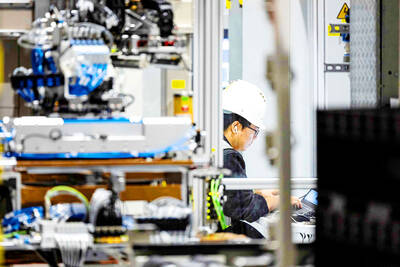A deepened global slowdown along with sluggish private consumption yesterday led a think tank to lower its GDP growth forecast to 4.1 percent for this year, down from its estimate in June of 4.6 percent, with government spending expected to play a key role in driving growth.
Though exports posted a robust showing in the first half, domestic demand decelerated faster than expected, indicating the economic slowdown had spread to Taiwanese consumers, the Taipei-based Polaris Research Institute (寶華綜合經濟研究院) said in a report.
“We expect the economy to slow to 4.1 percent this year,” institute president Liang Kuo-yuan (梁國源) said at a press conference yesterday. “There is still room for downward adjustment if the government fails to carry out its spending program in an effective fashion.”
The government is spending some NT$130 billion (US$4.06 billion) on public construction projects nationwide in the hope of boosting the GDP growth rate by 0.45 percentage points by the end of this year.
Liang said that domestic contractors were not eager to bid for the infrastructure projects because increasing raw material costs could cut into profits.
The institute put the projected GDP growth at 2.82 percent and 3.17 percent for the third and fourth quarters respectively, with government spending expected to contribute 20 percent and 36 percent in that order.
Meanwhile, exports are expected to slow to 4.88 percent and 1.21 percent on falling demand and deteriorating trade terms, the report said. Overseas shipments expanded 11.83 percent and 9.16 percent in the first and second quarters, government data showed.
Liang said the uncertain outlook in China following the Beijing Olympic Games posed an additional challenge in light of Taiwan’s increasing dependence on its giant neighbor’s markets.
In terms of demand, the economist forecast that consumer spending would continue to weaken as export growth has failed to benefit domestic industries or their workers, whose wages have been steadily eroding since 1990.
“The trend makes government measures to lift private consumption futile,” Liang said. “I don’t see a remedy in the foreseeable future.”
The report speculated that the local currency will trade at an average of NT$31.2 against the greenback this year, compared with the NT$30.3 it projected three months ago.
Liang attributed the revision to the rising demand for US dollars as a better investment option than other currencies amid the global financial turmoil.
The report projected yearly inflation would reach 3.8 percent, from the previous estimate of 3.4 percent, adding that consumer prices would remain high in the second half even though oil costs had dropped significantly.
In related news, Standard Chartered Bank predicted in a note released yesterday that the central bank would end four years of tightening measures and keep the discount rate unchanged at 3.625 percent at its board meeting next Thursday, in the hope of bolstering sagging market confidence.
The UK lender observed the central bank was keeping close tabs on financial markets that have suffered in recent days on cash woes plaguing major US investment institutions.
The central bank has repeatedly hiked discount rates since October 2004 to help stabilize commodity prices.

CHIP RACE: Three years of overbroad export controls drove foreign competitors to pursue their own AI chips, and ‘cost US taxpayers billions of dollars,’ Nvidia said China has figured out the US strategy for allowing it to buy Nvidia Corp’s H200s and is rejecting the artificial intelligence (AI) chip in favor of domestically developed semiconductors, White House AI adviser David Sacks said, citing news reports. US President Donald Trump on Monday said that he would allow shipments of Nvidia’s H200 chips to China, part of an administration effort backed by Sacks to challenge Chinese tech champions such as Huawei Technologies Co (華為) by bringing US competition to their home market. On Friday, Sacks signaled that he was uncertain about whether that approach would work. “They’re rejecting our chips,” Sacks

It is challenging to build infrastructure in much of Europe. Constrained budgets and polarized politics tend to undermine long-term projects, forcing officials to react to emergencies rather than plan for the future. Not in Austria. Today, the country is to officially open its Koralmbahn tunnel, the 5.9 billion euro (US$6.9 billion) centerpiece of a groundbreaking new railway that will eventually run from Poland’s Baltic coast to the Adriatic Sea, transforming travel within Austria and positioning the Alpine nation at the forefront of logistics in Europe. “It is Austria’s biggest socio-economic experiment in over a century,” said Eric Kirschner, an economist at Graz-based Joanneum

BUBBLE? Only a handful of companies are seeing rapid revenue growth and higher valuations, and it is not enough to call the AI trend a transformation, an analyst said Artificial intelligence (AI) is entering a more challenging phase next year as companies move beyond experimentation and begin demanding clear financial returns from a technology that has delivered big gains to only a small group of early adopters, PricewaterhouseCoopers (PwC) Taiwan said yesterday. Most organizations have been able to justify AI investments through cost recovery or modest efficiency gains, but few have achieved meaningful revenue growth or long-term competitive advantage, the consultancy said in its 2026 AI Business Predictions report. This growing performance gap is forcing executives to reconsider how AI is deployed across their organizations, it said. “Many companies

France is developing domestic production of electric vehicle (EV) batteries with an eye on industrial independence, but Asian experts are proving key in launching operations. In the Verkor factory outside the northern city of Dunkirk, which was inaugurated on Thursday, foreign specialists, notably from South Korea and Malaysia, are training the local staff. Verkor is the third battery gigafactory to open in northern France in a region that has become known as “Battery Valley.” At the Automotive Energy Supply Corp (AESC) factory near the city of Douai, where production has been under way for several months, Chinese engineers and technicians supervise French recruits. “They